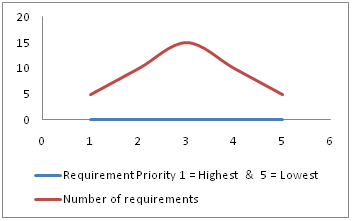Friday, September 03 2010
This Exercise assumes you are leaning more towards Buying an off-the-shelf application rather than Building one. Still, if you are considering the latter, you may be interested in off-the-shelf application considerations....
Take a moment to reflect back on your application’s key features and user interface from Exercise 2. How many key features did you document? Are they all of equal, #1 importance? Can any be reduced in importance or set aside for now? It may be exceptionally difficult if not impossible to find a suitable off-the-shelf application if all of your requirements are an equally high, #1 priority or #2 for that matter. Realistically, you’re going to need to consider prioritizing your requirements and to look for an application that meets the most important priorities for now. Imagine your requirements in a bell curve like the graph shown below. On a scale of 1 to 5 with 1 being Highest and 5 being Lowest, the majority of your requirements should fall in the 2 to 4 range.  Using your results from Exercise 2 or the To Build or Buy Worksheet Tool from Exercise 3, try, as best you can, to prioritize your requirements using a bell curve type of distribution. In a spreadsheet, list the features in rows going down and the priorities in columns going across. Put a number 1 in the appropriate row/column intersection. Then, total your numbers for each column. You can eyeball your results to roughly evaluate the distribution. Alternatively, you can take the total number for each column divided by the total number of all requirements and calculate the percentage. If your results are very skewed from a bell curve type of distribution, review your list of priorities again. Go through this process with your key contacts. Chances are, they may see things from a different perspective and can help you ‘normalize’ the curve. After you have a more even bell curve of requirements, your product research begins. Search engines, blogs, and industry colleagues may provide some promising suggestions. If your search turns up few/no results, your I.T. department, software product or consulting companies or a Software Product Specialist may be able to point you in a helpful direction. At the end of the day, if you find an off-the-shelf application that meets more than 75% of your highest priority requirements (i.e., #1 – 3 or 4) this may be most cost effective for your organization in the long run. Mark Lutchen, head of Pricewaterhouse Coopers IT Effectiveness practice and former global CIO said “Everybody knows that the more standardized you are and the more you buy off-the-shelf, the more cost effective it will be for both implementation and ongoing maintenance.”1 If possible, evaluate more than one off-the-shelf application before narrowing down your list. Product webinars or one-on-one demo’s could give you a good sense as to whether an application will meet your highest priority requirements. Invite key colleagues to attend a follow up webinar or demo if you find a promising solution or two. Include your I.T. staff in the process and the decision making if implementation of the product will impact them in any way. Product brochures may also contain helpful information to assist you in doing an initial comparison of product versus product. Also document if the company offers a pilot, risk free trial or other offer suited to your needs. Once you have obtained a shortlist of solutions, compare them against each other based on your #1 - #3 (4) priorities. Which is the best fit? What is the initial cost and effort to implement? Remember to include the costs of documentation, training, support and even software and hardware updates following implementation. Those maintenance and support costs can really add up after your initial purchase. Finally, it bears mentioning – again – to try and limit the #1 or highest priority requirements that you and your colleagues may have. (Do you sense this is a recurring theme in this type of endeavour?) Not reigning in the scope of what you absolutely need could end up being cost, time and/or resource prohibitive and your application may never see the light of day.... Minimizing the number of your highest priority requirements can be a major challenge. Have you gone through this process? How were you able to manage it? If you’re struggling with it, perhaps we can help. We and our readers would love to hear your words of wisdom on this difficult, but ultimately rewarding process. 1 Polly S. Traylor, InfoWorld, November, 2009. http://www.infoworld.com/d/applications/build-or-buy-it-applications-676 Comments:
|